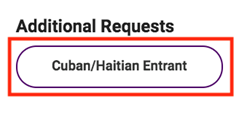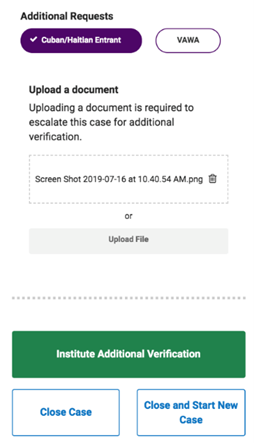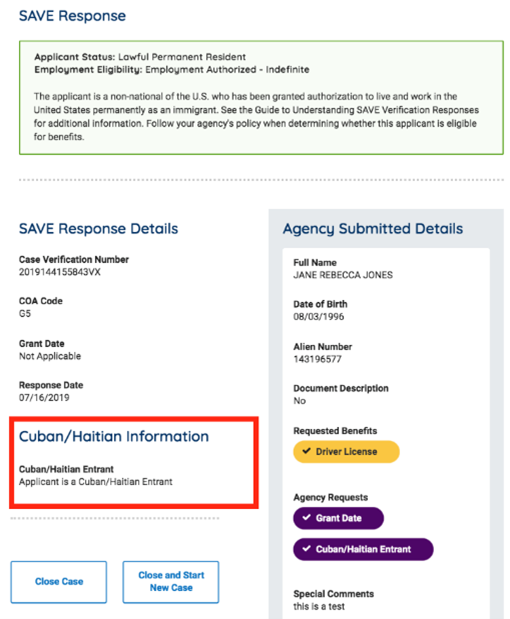Information for SAVE Users: Cuban-Haitian Entrants
Background
The term “Cuban-Haitian Entrant” (CHE) relates to benefit eligibility rather than an immigration status. Individuals who meet the definition of a CHE may be eligible for certain public benefits.
Definition
Section 501(e) of the Refugee Education Assistance Act of 1980 (REAA) states that an individual is a CHE if they are:
- An individual granted parole as a Cuban-Haitian Entrant (Status Pending) or any other special status[1] subsequently established under the immigration laws for nationals of Cuba or Haiti, regardless of the status of the individual at the time assistance or services are provided;[2] or
- A national of Cuba or Haiti who is not subject to a final, non-appealable and legally enforceable removal order, and:[3]
- Was paroled into the United States and has not acquired any other status under the Immigration and Nationality Act; or
- Is in removal proceedings under the Immigration and Nationality Act; or
- Has an application for asylum pending with USCIS.
Public Benefit Eligibility
Cuban-Haitian Entrants are “qualified aliens” under the Personal Responsibility and Work Opportunity Reconciliation Act (PRWORA) of 1996 and may be eligible for certain federal public benefits, including Medicaid, Refugee Cash and Medical Assistance, Refugee Social Services, Social Security, Supplemental Security Income (SSI), Supplemental Nutrition Assistance Program (SNAP), Temporary Assistance for Needy Families (TANF), and Federal Student Aid.[4] If an applicant does not have another qualifying immigration status or category for these benefits, or has a qualifying immigration status that is subject to the five-year waiting period reflected in 8 U.S.C. § 1613 (also called the “five-year bar”),[5] then the benefit-granting agency may need to determine that an applicant is a CHE.[6]
Documentation
The following chart provides examples of documentation that may be presented by a person claiming to be a CHE. The examples are not comprehensive. In particular, many Cubans or Haitians who have been paroled are CHEs based upon the parole even if they have obtained another immigration status. CHEs may have a wide variety of immigration documentation, including Permanent Resident Cards (Green Cards), that may not conclusively establish whether they are CHE without SAVE verification.[7]
| U.S. Immigration Category | U.S. Immigration Documents | Cuban or Haitian Nationality |
|---|---|---|
| Parole as CHE (Status Pending) | Form I-94, Arrival/Departure Record, with a Department of Homeland Security or legacy Immigration and Naturalization Service stamp noting “Cuban-Haitian Entrant (Status Pending).” | U.S. immigration documentation is evidence of nationality. No additional evidence of nationality required. |
| Parole or other special status |
| If Born In Cuba:
If Born Outside Cuba:
Note: A Cuban consular certificate documenting an individual’s birth outside of Cuba to at least one Cuban parent is not sufficient evidence to establish Cuban citizenship. This is true even if the consular certificate states that the individual to whom the certificate was issued is a Cuban citizen. Note: A Cuban birth certificate acknowledging a birth outside of Cuba or Cuban consular birth record issued for a principal applicant who was not born in Cuba is not sufficient to prove Cuban citizenship. A birth certificate issued by an entity outside of Cuba is not sufficient evidence to establish Cuban citizenship. If Born In Haiti:
If Born Outside Haiti:
|
| Pending Asylum |
| |
| Individual in Removal Proceedings | Documentation issued by the Department of Homeland Security (DHS) or the Department of Justice (DOJ) Executive Office for Immigration Review (EOIR) may indicate removal proceedings, such as DHS Form I-862, Notice to Appear, and DHS Form I-220A Order of Release on Recognizance.[9] Note: A DHS Form I-220B, Order of Supervision, is not evidence of parole or that an individual is in removal proceedings. |
SAVE Verification
Verification Request
SAVE user agencies that are authorized to receive CHE information may request it by selecting the Cuban/Haitian Entrant button when submitting their SAVE case for verification. After receiving a response to an initial verification request, ensure that the Cuban/Haitian Entrant button is selected.
If you select the Cuban/Haitian Entrant button, you must upload a copy of documentation that establishes the applicant is a CHE. Please see the Documentation section above and then upload a copy of the documentation:
- Drag and drop the file into the blue “Drag file to upload” box; or
- Click the Upload File button and use your browser to select the file.
Once you have uploaded the file, click Institute Additional Verification to submit the verification request.


SAVE Response
SAVE then reviews and researches the case. SAVE will display Case Under Review in a yellow box at the top of the SAVE response screen until the research is complete.
If Cuban/Haitian Entrant data is available, it will be displayed under the SAVE Response Details on the left side of the page.
Records Correction and Other Safeguards
User agencies that believe any part of a SAVE response is incorrect, including any CHE information, should contact the SAVE Resolutions and Audits unit using the contact information provided in the SAVE Program Guide.
If a user agency denies a benefit application based solely or in part on the SAVE response, the user agency must provide the applicant with adequate written notice and information to contact DHS so that they may correct their records in a timely manner. Notice is sufficient if a user agency provides the applicant with the SAVE Records: Fast Facts for Benefit Applicants sheet from the SAVE website or a successor SAVE Fact Sheet. User agencies must provide all applicants denied a benefit based partly or completely upon a SAVE response with the opportunity to challenge the denial through the agency’s process for appealing or contesting the denial.

Further Information
User agencies who need further information about SAVE verification of CHE should contact SAVE through established channels.
[1] Cuban and Haitian nationals paroled into the United States under section 212(d)(5) of the Immigration and Nationality Act since October 10, 1980 are considered paroled in a “special status” for Cuban or Haitian nationals unless the parole into the United States was (1) in the custody of a Federal, State, or local law enforcement or prosecutorial authority for purposes of criminal prosecution in the United States, or (2) solely to testify as a witness in proceedings before a judicial, administrative, or legislative body in the United States. 8 C.F.R. § 212.5(h).
[2] REAA § 501(e)(1).
[3] REAA § 501(e)(2).
[4] 8 U.S.C. § 1641(b)(7).
[5] CHEs are excepted from the five-year waiting period in 8 U.S.C. § 1613. See 8 U.S.C. § 1613(b)(1)(D).
[6] For example, an applicant may be a “qualified alien” under PRWORA due to having an eligible immigration status such as Lawful Permanent Resident or being paroled into the U.S. for more than one year, but they may still be subject to a five-year waiting period for federal means-tested public benefits (specifically Medicaid, CHIP, TANF, SNAP, and SSI) from the date they became a “qualified alien.” 8 U.S.C. § 1613(a). However, if they are also a CHE, they are a “qualified alien” and also exempt from the five-year waiting period. 8 U.S.C. § 1613(b)(1)(D).
[7] A Form I-551, Permanent Resident Card, with a CU6, CH6, HB6, or other category code is an example of an immigration document that does not conclusively establish CHE designation without SAVE verification.
[8] Please visit the Department of State Reciprocity Schedule for the Republic of Haiti webpage to obtain information about Haitian Birth Extracts.
[9] Removal proceedings begin when DHS files a Notice to Appear (NTA) with the Immigration Court after it is served on the individual. 8 C.F.R. §§ 1003.13, 1003.14. Individuals with A-numbers can access the EOIR Automated Case Information system at 1-800-898-7180 or acis.eoir.justice.gov/en to check the status of their case. If the NTA has not been filed with the Immigration Court, the EOIR electronic system will have no information.
